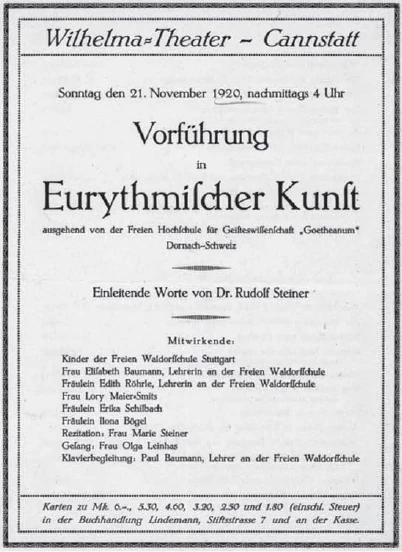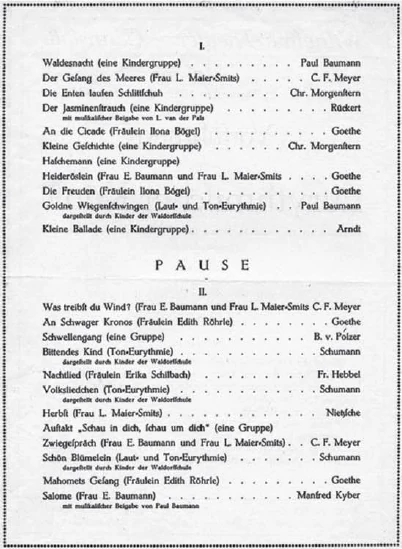The Origin and Development of Eurythmy
1920–1922
GA 277c
21 November 1920, Cannstatt
Translated by Steiner Online Library
15. Report of an Eurythmy Performance


No notes of the speech given by Rudolf Steiner before the performance have been preserved, but the newspaper report gives some of its contents.
Report from the Cannstatter Zeitung, November 23, 1920
Eurythmic Art
To come straight to the point; because the rush could not be met by far, today, Tuesday, the 23rd, there will be a repeat of the eurythmic art performance at the Wilhelmatheater. The performance on Sunday evening, which originated from the 'Freie Hochschule für Geisteswissenschaft', Goetheanum in Dornach-Switzerland, thus had a full house. Dr. Rudolf Steiner introduced the performance with a remarkable address, in which he emphasized the most essential aspects of the nature and aims of the eurythmic art. It is not some kind of dance, not some kind of mimicry, not gestures as a means of expression, but a real, visible language; the movements take place in strict accordance with the law. That which lies in the poem, in the song, in the piece of music, becomes visible to the eye through a different kind of expression, through a kind of formal language, just as the sounds of music become visible to the ear. In a poem or a piece of music, it is the 'how' that is art, not the 'what'. Before Schiller wrote a poem, he always had an indefinite melody in his soul, and that was the main thing. The actual artistic aspect of poetry only becomes a true revelation when the human being makes himself an artistic instrument, when the lawful movements are intended to express his soul life, his entire spiritual existence. This is the artistic side of eurythmy. However, this is juxtaposed with the pedagogical-didactic element. This is why the Freie Waldorf School in Stuttgart was founded. Here everything that has been developed from anthroposophically oriented spiritual science is to be cultivated. First and foremost, the will initiative that is so necessary for our time and the striving for truth. Eurythmy is still in its infancy, but it can be perfected and should ultimately place the human being at the pinnacle of nature, so that he makes himself a work of art. Then it will be able to stand alongside the older arts as a fully-fledged, younger art. These words, which were received with enthusiastic applause, were followed by 22 performances, which all went extremely well and were, in some cases, highly artistic. The simplicity, appropriateness, and functionality of the costumes were very pleasing, and yet the changing of the colored lights created very charming effects. From the wide range of performances, just a few were selected: the very first number, Forest Concert, with the soft, melodious singing of Ms. Olga Leinhas. Nietzsche's “The Sea's Ever-Changing Song” was vividly presented by Ms. L. Maier-Smits, as was “Autumn.” The renditions of “To the Cicada” by Miss Ilona Bögel, “To Brother Kronos” and “Mahomet's Song” by Miss Edith Röhrle, and “Song of the Night” by Miss Erika Schilbach were admirable. As teacher and at once champion, Ms. Baumann gave the masterpiece Salome in the final number, along with many others. Dr. Steiner, who presented the poems with great creativity, played a large part in the success. The children who participated were a source of great joy. The cute little ones had to be seen performing The Ducks Ice Skating. The older children also received plenty of applause after every number and had to repeat. Mr. Baumann accompanied them skillfully on the piano. We are sure that the theater will be full again on Tuesday.
15. Programm zur Aufführung


Von der Ansprache, die Rudolf Steiner vor der Aufführung hielt, haben sich keine Aufzeichnungen erhalten, doch gibt der Zeitungsbericht einige Inhalte derselben wieder.
Bericht aus der Cannstatter Zeitung, 23. November 1920
Eurythmische Kunst
Um es gleich vorwegzunehmen; Weil dem Andrang weitaus nicht entsprochen werden konnte, findet heute Dienstag, dem 23. ds. eine Wiederholung der Vorführung eurythmischer Kunst im Wilhelmatheater statt. Die Vorführung am Sonntagabend, die von der «Freien Hochschule für Geisteswissenschaft», Goetheanum in Dornach-Schweiz ausging, hatte also ein volles Haus. Dr. Rudolf Steiner leitete die Vorführung mit einer bemerkenswerten Ansprache ein, worin er über das Wesen und die Ziele der eurythmischen Kunst das Wesentlichste hervorhob. Es handle sich nicht um irgendeine Tanzkunst, nicht um irgend etwas Mimisches, nicht um Gesten als Ausdrucksmittel, sondern um eine wirkliche, sichtbare Sprache; die Bewegungen vollziehen sich streng gesetzmäßig. Das, was im Gedicht liegt, in Gesang, im Musikstück, wird durch eine andere Art des Ausdrucks, durch eine Art Formsprache anschaulich für das Auge, wie die Klänge der Musik für das Ohr. Im Gedicht, im Musikstück ist dasjenige erst Kunst, was durch das Wie zum Ausdruck kommt, nicht durch das Was. Ehe Schiller ein Gedicht hinschrieb, hatte er immer eine unbestimmte Melodie in der Seele, und diese war die Hauptsache. Das eigentlich Künstlerische der Dichtung wird nur wirkliche Offenbarung dadurch, dass der Mensch sich selbst zum künstlerischen Instrument macht, dass gesetzmäßige Bewegungen der Ausdruck sein sollen für sein Seelenleben, sein ganzes geistiges Dasein. Das ist die künstlerische Seite der Eurythmie. Dieser einen Seite steht jedoch gegenüber das pädagogisch-didaktische Element. Daher wurde die Freie Waldorf-Schule Stuttgart gegründet. Hier soll all das gepflegt werden, was aus der anthroposophisch orientierten Geisteswissenschaft sich entwickelt. In erster Linie die für unsere Zeit so notwendige Willensinitiative und das Streben nach Wahrheit. Die Eurythmie steht noch in ihren Anfängen, aber sie ist vervollkommnungsfähig und soll zuletzt den Menschen auf den Gipfel der Natur stellen, dass er sich selber zum Kunstwerk macht. Dann wird die sich als vollberechtigte, jüngere Kunst neben die älteren Künste hinstellen können. An diese, mit lebhaftem Beifall aufgenommenen Worte reihten sich nun in harmonischer Abwechslung, wie eine schöne Perlenschnur, 22 Vorführungen, die alle ganz vorzüglich gelangen, und teilweise hohe Kunstleistungen waren. Sehr angenehm berührte die Einfachheit, Schicklichkeit und Zweckmäßigkeit der Kostüme, und doch wurden durch den Wechsel farbiger Lichter ganz reizvolle Effekte erzielt. Aus der reichen Fülle des Gebotenen sei nur einiges wenige herausgegriffen: Gleich die erste Nummer Waldkonzert mit dem weichen, einschmeichelnden Gesang von Frau Olga Leinhas. Des Meeres ewig wechselvolles Lied fand wie auch Herbst von Nietzsche plastische Darstellung durch Frau L. Maier-Smits. Bewundernswert war die Wiedergabe von An die Zikade durch Frl. Ilona Bögel, An Schwager Kronos und Mahomets Gesang durch Frl. Edith Röhrle and Nachtlied durch Frl. Erika Schilbach. Als Lehrerin und sogleich Meisterin gab Frau Baumann neben manchem anderen in der Schlussnummer Salome noch das Meisterstück. Großer Anteil am Erfolg gebührt Frau Dr. Steiner, welche die Dichtungen mit starker Gestaltungskraft vortrug. Seine helle Freude konnte man an den mitwirkenden Kindern haben. Die herzigen Kleinen muss man gesehen haben, wie sie Die Enten laufen Schlittschuh vorführten. Auch die Größeren ernteten bei jeder Nummer reichen Beifall und mussten wiederholen. Herr Baumann begleitete gewandt am Klavier. Wir sind überzeugt, dass es am Dienstag wieder ein volles Haus geben wird.

